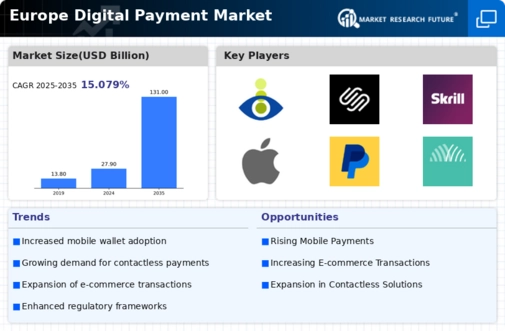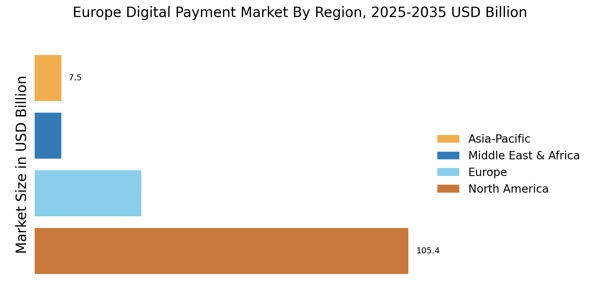Growing E-commerce Adoption
The digital payment market in Europe is experiencing a notable surge due to the increasing adoption of e-commerce. As consumers increasingly prefer online shopping, the demand for seamless digital payment solutions rises. In 2025, e-commerce sales in Europe are projected to reach approximately €500 billion, indicating a robust growth trajectory. This shift necessitates efficient payment methods that cater to consumer preferences, thereby driving innovation in the digital payment market. Retailers are compelled to integrate diverse payment options, including digital wallets and contactless payments, to enhance customer experience. Consequently, the digital payment market is likely to witness a significant transformation as businesses adapt to the evolving landscape of consumer behavior.
Consumer Demand for Convenience
Consumer preferences in Europe are shifting towards convenience, significantly impacting the digital payment market. As lifestyles become increasingly fast-paced, individuals seek payment solutions that offer speed and ease of use. The rise of mobile wallets and one-click payment options reflects this demand for convenience. In 2025, it is projected that mobile payment transactions will account for over 50% of all digital payments in Europe. This trend compels businesses to adopt user-friendly payment interfaces and streamline transaction processes. Consequently, the digital payment market is likely to evolve, focusing on enhancing user experience and minimizing friction in payment transactions. This consumer-driven shift is expected to drive innovation and competition among payment service providers.
Increased Focus on Cybersecurity
As the digital payment market expands in Europe, the focus on cybersecurity becomes paramount. With the rise in digital transactions, the risk of cyber threats also escalates, prompting businesses to invest in robust security measures. In 2025, it is estimated that cybersecurity spending in the payment sector will exceed €10 billion, reflecting the industry's commitment to safeguarding consumer data. Enhanced security protocols, such as end-to-end encryption and multi-factor authentication, are being implemented to mitigate risks. This heightened emphasis on cybersecurity not only protects consumers but also fosters trust in digital payment solutions. As a result, the digital payment market is likely to experience sustained growth, driven by the assurance of secure transactions.
Regulatory Support for Digital Transactions
Regulatory frameworks across Europe are evolving to support the digital payment market. Initiatives such as the European Union's PSD2 directive aim to enhance competition and innovation in payment services. This regulatory environment encourages financial institutions and fintech companies to develop new payment solutions, fostering a more dynamic market. As of 2025, it is estimated that compliance with these regulations will lead to a 20% increase in the adoption of digital payment methods among consumers. The emphasis on consumer protection and data security further strengthens trust in digital transactions, thereby propelling the growth of the digital payment market. This supportive regulatory landscape is likely to attract investments and stimulate technological advancements.
Technological Advancements in Payment Solutions
The digital payment market in Europe is significantly influenced by rapid technological advancements. Innovations such as blockchain technology and biometric authentication are reshaping payment processes, enhancing security and efficiency. In 2025, it is anticipated that the adoption of blockchain in payment systems could reduce transaction costs by up to 30%, making digital payments more appealing to businesses and consumers alike. Furthermore, the integration of artificial intelligence in fraud detection systems is expected to bolster security measures, thereby increasing consumer confidence in digital transactions. As technology continues to evolve, the digital payment market is poised for substantial growth, driven by the demand for faster and more secure payment solutions.


















Leave a Comment